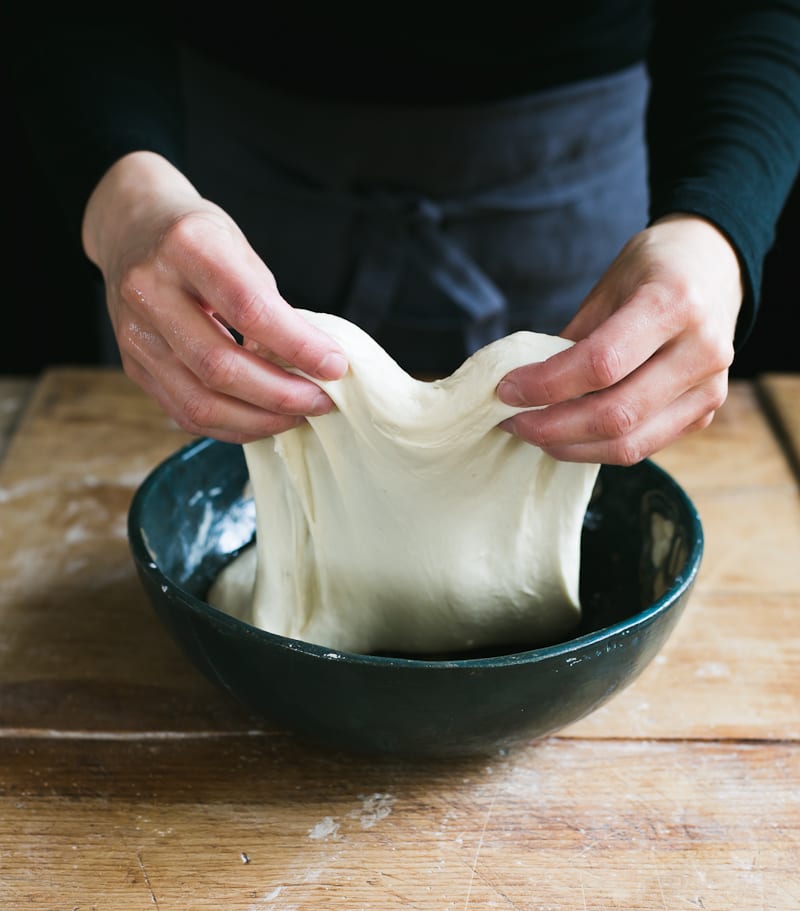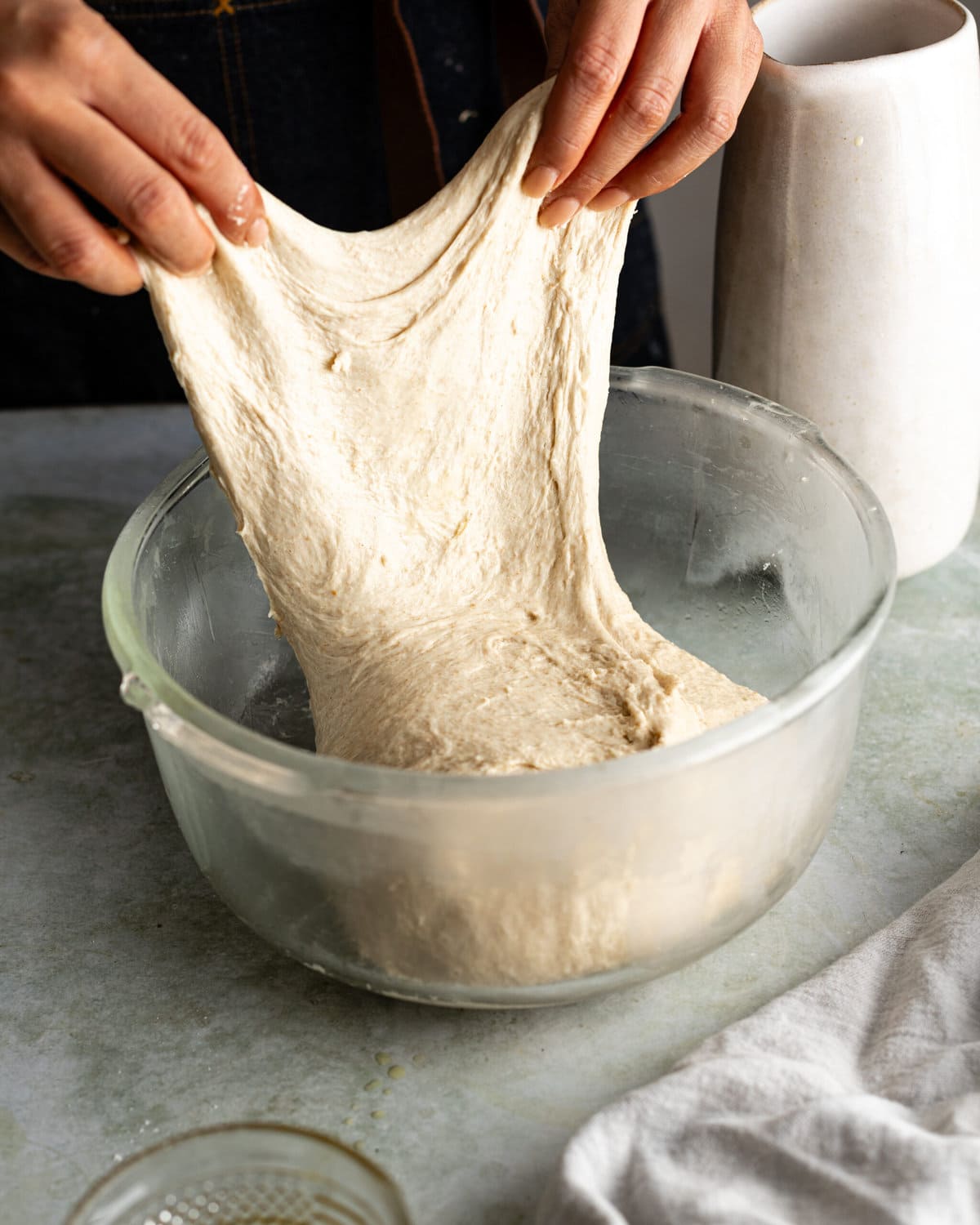Stretch and fold sourdough is a key technique in bread making. It helps develop gluten without kneading.
This method is simple, yet it makes a big difference in your sourdough bread. Whether you’re a beginner or a seasoned baker, mastering the stretch and fold technique can elevate your bread game. This method involves a series of gentle stretching and folding steps.
It strengthens the dough and improves its texture. By using this technique, you can achieve a bread with a chewy crumb and a beautiful crust. No need for fancy equipment or a lot of muscle work. Just a bowl, your hands, and a bit of time. Dive into the world of sourdough with this essential skill, and see how it transforms your baking.

Credit: www.youtube.com
Introduction To Stretch And Fold
The stretch and fold method is essential for making great sourdough bread. This technique helps develop gluten and strengthens the dough. Let’s dive into the basics and importance of this technique.
Basics Of Sourdough
Sourdough bread is a type of bread made using a natural fermentation process. It relies on wild yeast and lactic acid bacteria for leavening. These natural agents give sourdough its unique flavor and texture.
- Ingredients: Flour, water, salt, and sourdough starter.
- Fermentation: A long, slow process that develops flavor.
- Texture: Chewy with a crisp crust.
Making sourdough involves several steps, including mixing, fermenting, shaping, and baking. Each step is crucial for achieving the perfect loaf.
Importance Of Technique
The stretch and fold method is a key technique in sourdough baking. It helps develop the dough’s structure without kneading. This technique is gentle but effective.
| Step | Description |
|---|---|
| Step 1 | Gently stretch the dough. |
| Step 2 | Fold it over itself. |
| Step 3 | Rotate the bowl and repeat. |
Repeat this process several times during the bulk fermentation. It strengthens the dough and improves its texture. The stretch and fold method is gentle on the dough. It does not tear the gluten network.
Here are some benefits of using this technique:
- Improves dough strength.
- Enhances gluten development.
- Provides better loaf volume.
- Creates a more open crumb structure.
Using the stretch and fold method is simple and effective. It ensures your sourdough bread has the best possible texture and structure.
Benefits Of Stretch And Fold
The stretch and fold technique is a popular method in sourdough baking. It helps in developing the dough without much kneading. This technique is simple yet effective. Let’s dive into the benefits of using the stretch and fold method in your sourdough baking process.
Improved Gluten Development
One major benefit is the improved gluten development. Gluten is key for good bread texture. Stretching and folding helps in aligning the gluten strands. This results in a more elastic dough. An elastic dough traps air better, leading to a fluffier bread.
Unlike traditional kneading, the stretch and fold method is gentle. It does not tear the gluten strands. Instead, it strengthens them over time. This is especially important for sourdough, which needs a longer fermentation period.
Better Dough Structure
Another benefit is the better dough structure. The stretch and fold method creates a more uniform dough. A well-structured dough rises better and holds its shape. This results in a more aesthetically pleasing loaf.
Here is a simple comparison of the dough structure with and without stretch and fold:
| Without Stretch and Fold | With Stretch and Fold |
|---|---|
| Irregular crumb | Uniform crumb |
| Less volume | More volume |
| Flat shape | Better shape |
In summary, using the stretch and fold technique enhances your sourdough. It improves gluten development and ensures a better dough structure. Try incorporating it into your next baking session for better results!
Essential Tools And Ingredients
Creating the perfect sourdough bread starts with having the right tools and ingredients. Using the best materials ensures your bread has the right texture and flavor. Let’s dive into the essentials needed for the stretch and fold method.
Choosing The Right Flour
Flour is the foundation of your sourdough bread. It’s important to choose the right type to get the best results. Here are some types of flour you can use:
- All-Purpose Flour: Versatile and easy to find, it works well for most recipes.
- Bread Flour: Higher protein content, perfect for a chewier texture.
- Whole Wheat Flour: Adds a nutty flavor and more nutrients.
- Rye Flour: Gives a distinct taste, often used in combination with other flours.
For the best results, use organic and unbleached flours. They retain more nutrients and flavor.
Necessary Kitchen Tools
Having the right tools can make the bread-making process smoother. Here are the essential tools you’ll need:
| Tool | Purpose |
|---|---|
| Mixing Bowl | To mix and ferment the dough |
| Bench Scraper | Helps with kneading and shaping the dough |
| Kitchen Scale | Ensures accurate measurements |
| Proofing Basket | Supports the dough during the final rise |
| Baking Stone or Dutch Oven | Provides even heat distribution for baking |
| Lame or Sharp Knife | For scoring the dough before baking |
Using these tools will help you achieve a beautiful and delicious sourdough loaf. Each tool plays a crucial role in the bread-making process.
Step-by-step Guide
Crafting perfect sourdough bread requires patience and precision. This step-by-step guide will walk you through the process of stretch and fold sourdough. Follow these steps to achieve a light and airy loaf with a beautiful crumb structure.
Preparing The Dough
First, ensure you have all ingredients ready. You will need:
- 500g bread flour
- 350g water
- 100g sourdough starter
- 10g salt
Mix the flour and water in a bowl. Let it rest for 30 minutes. This is called autolyse. After resting, add the sourdough starter and salt. Mix well until everything is combined.
First Stretch And Fold
Once the dough is mixed, let it rest for 30 minutes. Now, it’s time for the first stretch and fold. Follow these steps:
- Wet your hands to prevent sticking.
- Gently pull one side of the dough upwards.
- Fold it over to the opposite side.
- Turn the bowl 90 degrees and repeat.
- Continue until all four sides are stretched and folded.
Let the dough rest for another 30 minutes.
Subsequent Folds
Repeat the stretch and fold process every 30 minutes for the next 2 hours. Here’s a quick schedule:
| Time | Action |
|---|---|
| 0:00 | First Stretch and Fold |
| 0:30 | Second Stretch and Fold |
| 1:00 | Third Stretch and Fold |
| 1:30 | Fourth Stretch and Fold |
| 2:00 | Final Stretch and Fold |
After the final fold, let the dough rest for 1 hour. This allows the gluten to develop fully.
Common Mistakes To Avoid
Learning the stretch and fold method for sourdough can be tricky. Many bakers make mistakes that affect the final bread. Below, we highlight some common errors to avoid.
Overworking The Dough
One common mistake is overworking the dough. Stretching and folding too much can damage the gluten network. This will make your dough tough and chewy.
Here are some tips to avoid overworking:
- Perform 3-4 sets of stretches and folds, spread out over a few hours.
- Be gentle. Use a light touch to avoid tearing the dough.
- Allow the dough to rest between sets. This helps relax the gluten.
Inconsistent Folds
Inconsistent folds can lead to uneven crumb structure. It is crucial to maintain consistency in your technique.
Steps to achieve consistent folds:
- Stretch the dough from one side and fold it over to the other side.
- Rotate the dough 90 degrees and repeat the stretch and fold.
- Continue this process for each set of folds.
Avoid these mistakes to achieve perfect sourdough. Happy baking!

Credit: www.theclevercarrot.com
Troubleshooting Tips
Mastering the art of stretch and fold sourdough can be challenging. You might encounter some common issues along the way. Here are some troubleshooting tips to help you achieve the perfect sourdough.
Fixing Overproofed Dough
Overproofed dough can be tricky. It loses its structure and can become very sticky.
- Gently reshape the dough: Carefully reshape it into a tight ball. Avoid pressing too hard.
- Cold proof: Place the dough in the refrigerator for a few hours. This helps it regain some strength.
- Reduce baking temperature: Lower the oven temperature by 25°F. It helps the dough rise slowly.
Handling Sticky Dough
Sticky dough can be difficult to manage. Here are some tips to make it easier.
- Wet your hands: Use water to prevent the dough from sticking to your hands.
- Use a bench scraper: A bench scraper can help you handle the dough without sticking.
- Add a bit of flour: Lightly dust the dough with flour. Be careful not to add too much.
Advanced Techniques
Sourdough baking can be a rewarding experience. Mastering the basic stretch and fold technique is key. But what about taking your sourdough to the next level? Advanced techniques can elevate your bread, making it unique and flavorful. Let’s dive into some of these advanced methods.
Incorporating Add-ins
Add-ins can transform your sourdough. Think nuts, seeds, or dried fruits. These ingredients add texture and flavor. Follow these simple steps:
- After the second stretch and fold, sprinkle your add-ins over the dough.
- Gently fold the dough to distribute the add-ins evenly.
- Continue with your regular stretch and fold routine.
This method ensures the add-ins are well incorporated. Remember not to overdo it. Too many add-ins can affect the dough’s structure.
Creating Unique Patterns
Creating patterns in your sourdough can be fun. It also makes your bread stand out. Here’s how to create unique patterns:
- Scoring: Use a sharp blade to make cuts on the dough’s surface. Experiment with different designs.
- Twisting: Twist the dough before the final proof. This technique can create beautiful swirls.
- Lamination: Stretch the dough into a thin layer. Fold it like a letter to create layers.
Each method can give your sourdough a unique look. Practice to find your favorite technique.

Credit: makeitdough.com
Conclusion And Final Thoughts
Stretch and fold sourdough technique ensures a strong dough structure and excellent texture. This method enhances the bread’s flavor and crumb without requiring intensive kneading. Enjoy a perfect homemade sourdough with this simple, effective approach.
In this section, we will wrap up our discussion on the stretch and fold method for sourdough. This method helps create a better dough structure and improves the final bread texture. Here are some key points to remember and encouragement to keep practicing.Summarizing Key Points
The stretch and fold technique involves stretching the dough and folding it over itself. This process strengthens the dough without kneading.- Reduces the need for kneading: Less physical effort needed.
- Improves gluten development: Better dough structure.
- Increases dough elasticity: Easier to shape.
- Promotes even fermentation: Better rise and texture.
- Wet your hands to prevent sticking.
- Lift one side of the dough and stretch it upwards.
- Fold it over to the opposite side.
- Rotate the dough 90 degrees and repeat.
- Complete 3-4 sets of stretches and folds.
Encouragement For Practice
The stretch and fold method may seem simple, but practice is key. Repeated practice helps you understand the dough better. Consistency leads to better results. Tips to keep in mind:- Be patient: Dough needs time to develop.
- Stay consistent: Follow the same process each time.
- Observe changes: Notice how the dough feels and reacts.
Frequently Asked Questions
What Is The Stretch And Fold Method?
The stretch and fold method is a technique used in sourdough baking. It helps develop gluten without kneading. This process strengthens the dough, improves structure, and enhances texture.
How Often Should I Stretch And Fold Sourdough?
Typically, you should perform the stretch and fold method every 30 minutes. Repeat this process 3-4 times during the bulk fermentation period. This ensures the dough develops well.
Why Is Stretch And Fold Important?
Stretch and fold is important because it helps develop gluten structure. This results in a better crumb and rise. It also creates a more elastic and strong dough.
Can I Skip The Stretch And Fold Step?
Skipping the stretch and fold step is not recommended. This step is crucial for gluten development. It significantly impacts the dough’s final texture and strength.
Conclusion
Mastering the stretch and fold technique is simpler than it seems. Practice makes perfect. This method strengthens your sourdough and improves texture. Patience and consistency are key. Soon, your sourdough will impress everyone. Enjoy the process and happy baking!



